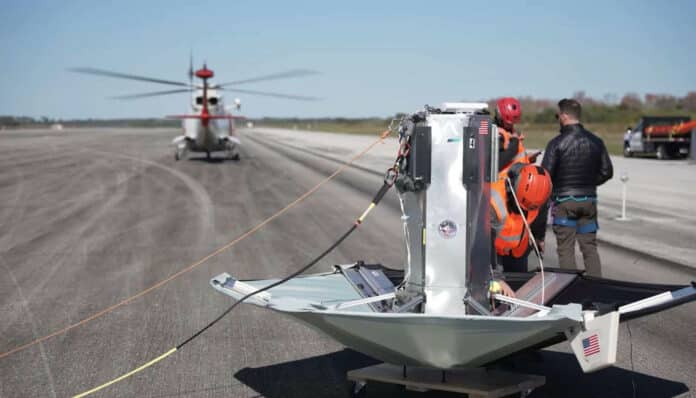Sierra Space, a space-tech company, has unveiled a radical new concept for on-demand cargo delivery from Earth orbit. The company has successfully beta-tested a revolutionary new logistics spacecraft, Sierra Space Ghost.
The advancements being made in space technology has the potential to benefit life on Earth and protect economic activity in the Orbital Age. This new technology promises to redefine the way critical defense supplies are delivered across the globe.
The Sierra Space Ghost Beta decelerator is a cutting-edge thermal protection system tailored for the safe return of small payloads from space.
The first drop test of the Sierra Space Ghost was conducted last month in Florida, providing valuable insights for Sierra Space test engineers about the system’s flight characteristics and ground recovery operations.
“As we continue to innovate at speed, this test enables us to build, test, learn, and accelerate the development of a revolutionary new operational asset for national security,” said Tom Vice, CEO of Sierra Space. “We envision having an inventory of Sierra Space Ghost vehicles strategically positioned and readily accessible and deployable within 90 minutes to critical locations anywhere on Earth. Sierra Space Ghost enables our customers to deliver vital resources to frontline personnel with unparalleled precision and speed.”
The ability to deliver critical supplies within such a short timeframe could potentially have a significant impact on conflicts. Imagine the possibility of pre-staged supplies waiting in an on-orbit inventory that could be deployed down to Earth within 100 yards of where they are needed.
Recently, Sierra Space performed a series of tests at Space Florida’s storied Launch and Landing Facility (LLF) in Florida. With the support of the Florida-based company Operator Solutions, three test articles were dropped from a Sikorsky S-76 helicopter to ensure stable flight for the hardware at subsonic speeds. Sierra Space will scale-up to hypersonic in upcoming tests.
The testing campaign was completed in just 90 days under Sierra Space’s Axelerator incubator charter. The key highlights of the campaign included a terminal drop (without a parachute) of the first test article from an altitude of 2,000 feet, which evaluated impact dynamics and payload integrity. The second highlight was the deployment of a parachute-equipped test article from 4,000 feet, demonstrating controlled descent and precise landing proximity. The final test involved the separation of shield and payload components in the third test article, showcasing advanced payload return capabilities.
The Sierra Space Axelerator – their innovation-at-speed incubator is designed to fast-track the development of revolutionary defense technologies and mission solutions. It’s a part of Sierra Space’s Orbital Missions and Services organization, which was founded in 2023 to focus on innovative national security solutions. Sierra Space has been awarded $1.3 billion in prime satellite constellations contracts.
The Sierra Space Ghost will now go through a robust beta testing program to develop operations in real-time. The beta testing will allow the Sierra Space test team to consider the infrastructure and architecture needed to operate the spacecraft, as well as the communications system, the data system, and the recording of every facet of operations.
The Sierra Space Ghost system, outfitted with predetermined supplies such as a survival kit, inflatable boat, rations, weaponry, etc., is designed to stay in orbit for up to five years. When called upon, the system re-orients and begins the re-entry and targeting cycle. The de-orbit motor slows the vehicle to 7,000 meters per second, and gravity then captures the vehicle, allowing it to re-enter Earth’s atmosphere with the thermal protection shield, which has temperatures up to 2,000 degrees Fahrenheit.
Once the vehicle passes through the atmosphere, the shield is discarded, leaving just the requested payload and a parafoil. At the right altitude, the parafoil is released, steering the payload to the required area within 100 meters.
